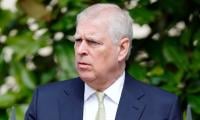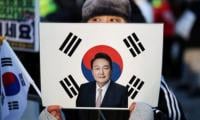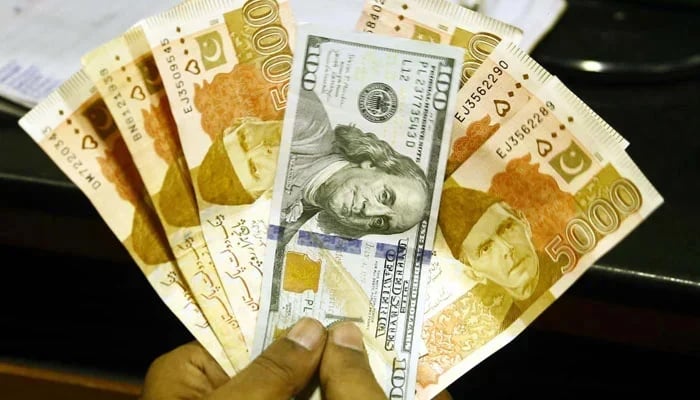KIBOR hits one-year bottom as market anticipates rate cuts
The KIBOR, which reflects the cost of funds in the interbank market, eased to 20.62 percent from 20.82 percent
KARACHI: The six-month Karachi interbank offered rate (KIBOR), a benchmark for lending and borrowing in Pakistan, fell to its lowest level in a year on Thursday, following an unexpected drop in treasury bill yields at an auction the previous day.
The KIBOR, which reflects the cost of funds in the interbank market, eased to 20.62 percent from 20.82 percent. It had peaked at 24.71 percent in September 2023.
The decline in the KIBOR came after the government raised Rs184 billion from the sale of treasury bills, less than its target of Rs225 billion. The cut-off yields for the three-month, six-month and one-year bills fell by 50 to 62 basis points, indicating lower borrowing costs for the government.
“After a surprise fall in yields in yesterday’s T-bill auction, today the benchmark lending rate (6-month KIBOR) fell from 20.82 percent [on Wednesday] to 20.62 percent, which is almost one year low,” said Mohammed Sohail, the CEO at Topline Securities Limited. “This lending rate peaked at 24.71 percent in September 2023.”
Brokerage Chase Securities said the one-year bill attracted the most investor participation, with the government obtaining Rs116 billion in this specific T-bill category.
Additionally, the government raised Rs293.6 billion from Pakistan Investment Bonds floaters, surpassing the Rs200 billion target. Interestingly, the deficit in T-bills was compensated by the surplus garnered from PIB Floaters, particularly in longer tenors of three, five, and 10 years.
Now, speculation is running high over whether the central bank will respond to these market dynamics by adjusting the policy rate next week or delay the monetary easing until March.
“As market rates experienced a steep decline, the secondary markets, in turn, influenced the KIBOR, reflecting an anticipation of rate cuts,” the brokerage said.
“The onus now lies on the State Bank of Pakistan (SBP) to adjust the benchmark rate, or policy rate, in response to these market dynamics or delay the decision till the March policy statement; however the market has already incorporated many rate cuts ahead in the current yields.”
The central bank will unveil its monetary policy on January 29.
Topline Research polled key market participants about their expectations for the policy rate and important macro forecasts to get their opinions on the outlook for monetary policy.
According to the survey, 68 percent of respondents think that the policy rate would stay at 22 percent, and the remaining 32 percent expect a reduction in the policy rate. Participants' expectations vary: 56 percent think the first rate drop will happen in March, 18 percent think it will happen in April, 13 percent think it will happen in June, and 12 percent expect it will happen after June.
The Monetary Policy Committee (MPC) of the SBP kept the policy rate unchanged at its meeting held on December 12, which came in line with market expectations. The MPC reiterated its earlier view that the real interest rate continues to be positive on a 12-month forward-looking basis and inflation is expected to remain on a downward path to achieve the inflation target of 5-7 percent by end-FY25.
They also reiterated that headline inflation will decline significantly in the second half of this fiscal year due to contained aggregate demand, easing supply constraints, moderation in international commodity prices, and favorable base effect.
However, the MPC also noted some new developments since its last meeting, which it will likely consider at the upcoming meeting. These include: a rise in consumer price inflation to 29.7 percent in December from 29.2 percent in November; a current account surplus of $397 million in December, compared with a deficit of $15 million in November; a slight decrease in local fuel prices; stable international oil prices; and a relatively stable exchange rate of the rupee against the dollar.
“Considering all the factors mentioned above, we also believe the SBP will keep the policy rate unchanged at 22 percent in the upcoming MPC meeting,” said an analyst at Topline Securities.
-
 Prince William Makes Clear The Conditions He Has For Meeting Prince Harry
Prince William Makes Clear The Conditions He Has For Meeting Prince Harry -
 Sara Foster Slams Age Gap Relationship After 'blah' George Clooney Date
Sara Foster Slams Age Gap Relationship After 'blah' George Clooney Date -
 Jennifer Garner Recalls Enduring Ben Affleck’s Intense Beyoncé ‘Halo’ Phase
Jennifer Garner Recalls Enduring Ben Affleck’s Intense Beyoncé ‘Halo’ Phase -
 Prince Harry’s Mental Health Ends Up At Stake As Meghan Moves Him To 'second Fiddle'
Prince Harry’s Mental Health Ends Up At Stake As Meghan Moves Him To 'second Fiddle' -
 Bradley Cooper On Who His Mother Thinks Is The World’s Best Actor
Bradley Cooper On Who His Mother Thinks Is The World’s Best Actor -
 Meghan Markle Offers Glimpse Into Intimate Dance Moment With Harry Amid Split Rumors
Meghan Markle Offers Glimpse Into Intimate Dance Moment With Harry Amid Split Rumors -
 Jon Bon Jovi Joins The Viral 2016 Throwback Trend With Nostalgic Photos
Jon Bon Jovi Joins The Viral 2016 Throwback Trend With Nostalgic Photos -
 Kate Middleton Hailed For Her Lack Of ‘obligation’ As Well As Altruistic, Selfless Qualities
Kate Middleton Hailed For Her Lack Of ‘obligation’ As Well As Altruistic, Selfless Qualities -
 Jason Momoa Says Being With Beau Adria Arjona Feels 'perfect'
Jason Momoa Says Being With Beau Adria Arjona Feels 'perfect' -
 Idris Elba Says One Mix-up Nearly Cost Him A Knighthood From King Charles
Idris Elba Says One Mix-up Nearly Cost Him A Knighthood From King Charles -
 Andrew Mountbatten Windsor Incurs Anger Of Biggest Royal
Andrew Mountbatten Windsor Incurs Anger Of Biggest Royal -
 Megan Fox, Machine Gun Kelly's Relationship 'is Just About Co-parenting'
Megan Fox, Machine Gun Kelly's Relationship 'is Just About Co-parenting' -
 Prince Harry, Meghan Markle Warned They Can’t Fool Brits Because It Won’t Land
Prince Harry, Meghan Markle Warned They Can’t Fool Brits Because It Won’t Land -
 South Korea’s Ex-president Yoon Suk Yeol, Sentenced To 5 Years In Prison: Key Details Explained
South Korea’s Ex-president Yoon Suk Yeol, Sentenced To 5 Years In Prison: Key Details Explained -
 Princess Beatrice Is ‘terrified’ Of Mom Fergie: ‘She’s Begging Her To Not Destroy Her Future’
Princess Beatrice Is ‘terrified’ Of Mom Fergie: ‘She’s Begging Her To Not Destroy Her Future’ -
 Harry Styles’ New Album Earns Subtle Nod From Zoe Kravitz’s Dad
Harry Styles’ New Album Earns Subtle Nod From Zoe Kravitz’s Dad




